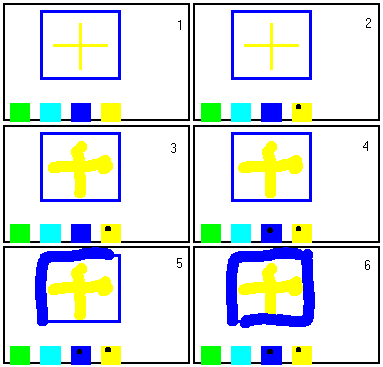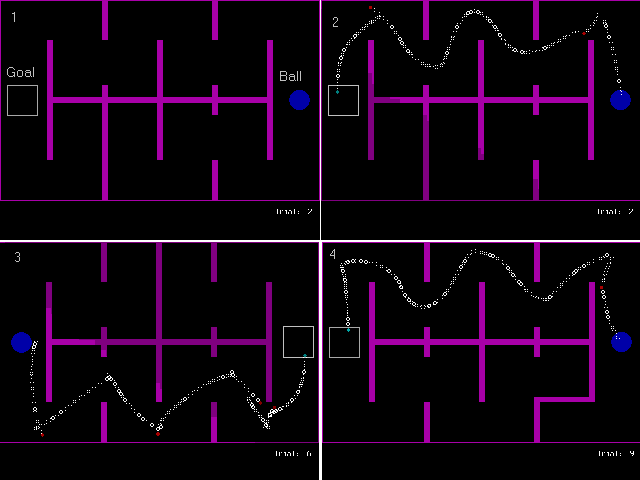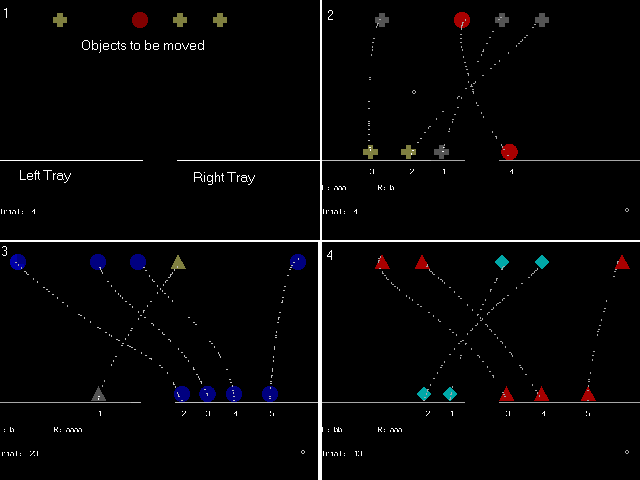
Automated training of line drawing and object movement (in fingermaze and sorting tasks) on a touch-sensitive monitor in captive chimpanzees (Pan troglodytes)
I.H. Iversen1 and T. Matsuzawa2
1 Department of Psychology, University of North Florida, Jacksonville, FL, U.S.A.
2 Primate Research Institute, Kyoto University, Inuyama, Japan
Two adult, captive, female chimpanzees (Pan troglodytes) were trained to trace lines presented on a touch monitor. Moving a finger over the monitor left a trace of electronic ink in the form of graphical symbols (filled circles). Tracing was analyzed on-line. Original training to draw in a controlled manner progressed from pressing individual dots on the monitor to moving the finger over the dots in a sweeping motion [1]. Training to trace multi-line stimuli progressed from tracing a single line to tracing two lines, then three lines, etc.

Figure 1 illustrates examples of the stimuli presented on the screen and what the screen looked like after tracing was completed. The stimuli were presented one at a time (each stimulus occupied a 15 by 15-cm area). When the subject pressed a switch next to the monitor the computer analyzed the drawing. Reinforcement was delivered if 95% of the stimulus was covered by ink and 95% of the ink covered the stimulus. Both subjects traced correctly on over 90% of all trials. Drawing became more efficient over time. Both subjects traced a variety of stimuli including all the letters of the alphabet. Both subjects also learned to trace lines of different color on the same trial. Figure 2 illustrates one trial of color tracing. On a palette at the bottom of the screen, the subject chooses the color with which the finger draws. The experiments demonstrate that with gradually progressive automated training using a tracing technique, the chimpanzee can be induced to draw complex stimuli in a highly reliable manner.

The same two subjects were trained to move visual objects presented on the monitor with a finger. By placing the finger on an object, the subject could move the object on the monitor from one location to another by sliding the finger over the surface and the object followed the finger movement. With the fingermaze task the subject had to move a ball into a goal box. First, these were the only objects on the monitor. Next, obstacles were presented on the monitor that the ball could not go through. The subject had to learn to move the ball so as to avoid the obstacles. Gradually the obstacles were made more complex and eventually formed a maze pattern. Both subjects learned to move the ball efficiently in the maze to minimize the number of times the ball hit an obstacle. Also, the subjects learned to avoid blind alleys. The analysis method allows for detailed assessment of movement patterns in the mazes.

Figure 3 shows some examples of maze patterns that the subjects solved. Frame 1 shows the maze and the ball and goal locations at trial start. Frame 2 shows the path the ball moved in the same maze. Frames 3 and 4 shows ball movement on other trials. The experiment shows how complex perceptual-motor skills can be examined in a completely automated fashion.

One chimpanzee was also trained on an object-sorting task. Figure 4 illustrates the task in a few trials. At trial start, the top of the screen shows some objects that may differ in color and shape. Frame 1 shows 4 objects in two categories. The bottom of the screen shows two horizontal lines, the trays. The objects have to be moved to the trays in any order but such that two categories are formed. Frame 2 shows the path of movement of each object. Although the objects are shown at the top in Frame 2, they were actually moved along the path and only appeared on the trays by the end of the movement. When the objects are all down on the trays, a press on a switch outside the monitor will enable the computer to evaluate the sorting and present reinforcement if sorting is correct. Frames 3 and 4 show the object movement paths on two other trials. Experiments demonstrated that primate object sorting, which ordinarily is done with real objects and by manual training, could be fully automated.
The presentation will focus on the computerized methods of recording, analyzing, and training. Video examples of the methods will be presented.

Paper presented at Measuring Behavior '98, 2nd International Conference on Methods and Techniques in Behavioral Research, 18-21 August 1998, Groningen, The Netherlands